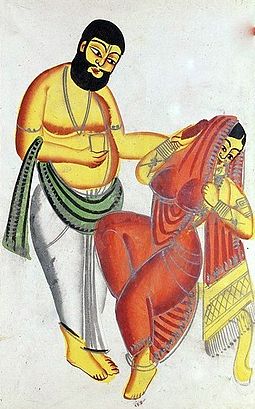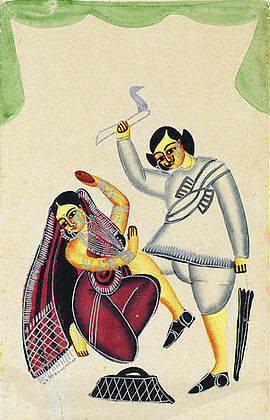Case Title:- Queen vs Nobin Chandra Banerjee.
It is also known as the Tarakeswar scandal or the Mahant-Elokeshi affair. It is famously named ‘Tarakeshwar Case’; due to the involvement of a priest (Mohanto) of the famous Shiv temple of Kolkata i.e. Tarakeshwar Temple.
That time Indians consider the crime of Adultery more heinous crime then the Murder.
This case comment is written by Rohan Singh, a student of law from Hidayatullah National Law University, Raipur.
CASE HISTORY
This case revolved around Murder and Adultery in the late 19th century. The murder by Nobin Chandra Bandopadhyay and adultery charges on the Mohanto of Tarakeshwar shrine. Unlike other cases of murder and adultery; this one caught the public eye and became a hot topic among the villagers and press. Newspapers covered the case right from the beginning and after the release of the accused. People also performed some plays related to the case of betrayal and adultery.
The tragedy also represented in drawings and paintings. The people supported Nobin’s killing of his wife and judged the move as a correct response to the adultery; that they believed his wife committed. But local arts and folk tales also suggest that; the Madhavchandra Giri, the “powerful” mahant of the popular and prosperous Tarakeswar temple, is the real evil person; who in the name of providing fertility medication to the Elokeshi, did the immoral act. An affair began with the consent of Elokeshi’s parents. (Though these are not proven facts but are prevalent equally in folk tales.)
FACTS OF THE CASE
On May 24th Nobin Chandra Bandopadhyay returned to Kumrul after leaving the city Calcutta; where he worked at a printing press. Nobin arrived at his Father-in-law Nilkamal Mukhopadhyay’s house and met his wife Elokeshi. The most important temple of Lord Shiva of Bengal, The Tarakeshwar Temple; was situated a few kilometers away from Nilkamal’s house.
Nobin took her wife to her grandmother’s house which was near his father-in-law’s house. After three days of staying in that house, Nobin slit Elokeshi’s throat and she died of excessive bleeding.
Nobin confessed his crime and was later revealed that; Elokeshi was having an affair with the Mohanto of the Tarakeshwar temple, Madhabchandra Giri. Nobin and the Mohanto both were represented before the court and were alleged with Murder and Adultery respectively.

The decision of the Hoogly Court came after Woomesh Chandra Bonnerjee defended Nobin with the logic; that Nobin’s act was merely an act in insanity and that he was not in control of himself; when he got to know about his wife’s affair. Bonnerjee tried to prove Nobin’s action was a result of temporary insanity; and he had no control over what he was saying or doing. The court agreed to the logic and held Nobin ‘not guilty’.
In the trial of adultery against Mohanto the session court held that Adultery is a criminal offence in British India; but a civil offence in other countries like Britain. The court sentenced Mohanto of the temple to 3 years of imprisonment along with a fine of Rs.2000.
Both the cases were appealed to the High Court.
ISSUES
TRIAL-1
- Whether Nobin was insane or not?
- Whether Nobin was clearly of unsound mind while committing the act or not?
TRIAL-2
- Whether Nobin and Elokeshi were married and was it a known fact or not?
- Did Nobin knew about the affair and accepted the same or not?
- Whether there was sufficient proof or evidence to tell; that sexual intercourse had occurred between the defendant and Elokeshi or not?
- Whether the defendant knew that his mistress was married or not?
For TRIAL 1
- If Nobin is proved of unsound mind at the time of committing the act; then he would be held not guilty of Murer of his wife Elokeshi.
For TRIAL 2
- If the marriage between Nobin and Elokeshi is not proved then the defendant would not be liable for adultery.
- Even after, if Nobin knowingly about the affair and accepted the same of his wife and defendant; then the defendant could not be charged with Adultery.
- If sexual intercourse had not taken place between Nobin’s wife and the defendant; then also the defendant could not be charged with Adultery.
- If the defendant was unaware of the fact that Elookeshi was already married then the defendant did no wrong of Adultery; as he was acting with a Bonafide intention.
HOLDING AND REASONING
Section 497 in The Indian Penal Code, 497.
Section 497 of the Indian Penal Code 1860 defines Adultery and also the relevant punishment for it.
Adultery— Whoever has sexual intercourse with a person who is and whom he knows or has reason to believe to be the wife of another man; without the consent or connivance of that man; such sexual intercourse not amounting to the offense of rape, is guilty of the offense of adultery; and shall be punished with imprisonment of either description for a term; which may extend to five years, or with fine, or with both. In such a case, the wife shall not be punishable as an abettor.
Section 300 of the Indian Penal Code defines Murder and section 302, defines its punishment.
TRIAL-1
The High Court held that there was no doubt that; Elokeshi was killed with a boti (a Kitchen Knife) by the defendant of which the defendant himself confessed. For the question of the unsoundness of mind of the defendant, while committing the act; the court held that the defendant had been excited but not insane while slitting his wife’s throat. The defendant acted under the influence of ‘anger, jealousy, and grief’; but had the sense that what he was doing was wrong.
The court declared the defendant sane and guilty of culpable homicide. The Court added that there is no sufficient evidence; that proved the defendant insane and unable to know the consequences of his act. Therefore, the court quashed the decision of the Hoogly Court; and sentenced the defendant under Section 302 of the Penal Code to transportation for life.
TRIAL-2
The High Court after the relevant arguments and proofs upheld the decision of the Subordinate Court; and sentenced the defendant (Mohanto) with 3 years of imprisonment and Rs.2000 of fine.
The court explained that it is adhering to the Hindu Law rites; and defending Hindu Law as Adultery was a criminal offense in British India. It was also noted that for the proof that the carnal intercourse took place between the defendant and Nobin’s Wife; the court accepted the testimony of three residents; who confirmed that they saw Elokeshi entering into the defendant’s house in the evening and returning in the morning.
The court accepted the testimony though they were weak proof; and also quoted the lines of Manu “a woman must never act independently of her husband.” and stated that a woman could not visit a religious festival or holy place alone. Finally, the court stated that they place the law above personal revenge and individual justice.
CONCLUSION
The Tarakeshwar case was one of the most popular and most controversial cases in British India. Unlike other cases of murder and adultery; this case caught everyone’s eye as the adultery was charged against the Mohanto of the Tarakeshwar Temple. According to the Criminal Statistics of 1870 to 1875; 20-40 percent of the murder cases involved the women having an extramarital affair; but most of them were just a mention of death in the police records, unlike Tarakeshwar case.
Adultery was considered as the crime of top-level sometimes more heinous than Murder by Indian societies in the 19th century. After the verdict of the High court, the native people forced the Governor-General to free Nobin as in their view; he did nothing wrong in punishing the young lady for disloyalty.
The court’s decision was indeed a correct one and the jury gave the judgment; as an independent unit without the influence of the society and societal pressure. According to the press, the tarakeshwar case was that popular that everyone can be heard talking about the incident. People started to perform plays performing the love triangle among the three protagonists of the story. Literary and artwork also tried to picturise the story.
After three years of the bail of Mohanto; Nobin was also released simultaneously the press reasoned it with the pressure of the society.
REFERENCES
Websites
Statutes
Indian Penal Code, 1860
Books
- The Indian Penal Code: A critical commentary – Harish Chander
- Indian Penal Code, 1860, s497.
- The Indian Penal Code, 1860, s300.
- Indian Penal Code, 1860, s302.




